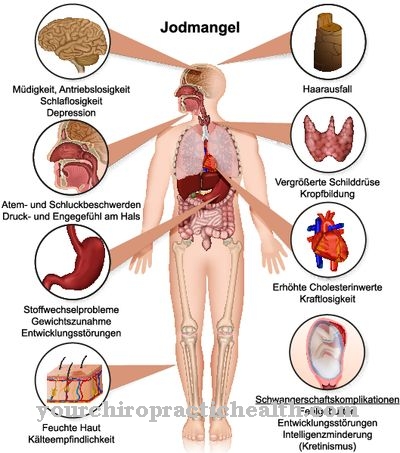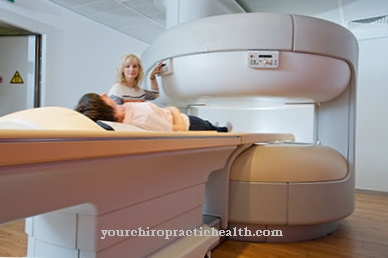The so-called Clivuskanten Syndrome describes a major clinical feature due to a horizontal displacement of the brain stem in the upper area. The oculomotor nerve is damaged by increased pressure in the tentorium slit. The causes are subdural hematomas after cerebral haemorrhage or head trauma.
What is Clivuskanten Syndrome?

© GraphicsRF - stock.adobe.com
Clivuskanten syndrome is the main symptom of brain damage that occurs as a result of a rapidly increasing intracranial increase in pressure caused by subdural hematomas. The causes for this are various head trauma or cerebral hemorrhages of all kinds, which can occur, for example, in tumors. The so-called oculomotor nerve is pressed laterally by the gyrus hippocampi onto the clivus Blumenbachii, which is located on the sella turcica.
This leads to irritation of the focal ocular motor, which manifests itself in a fleeting irritation miosis and a homolateral narrowing of the pupils. In the later course, an oculomotor paralysis appears, which is accompanied by an absolute rigidity of the pupils and a unilateral mydriasis. Ultimately, all outer oculomotor branches fail completely. This clinical picture is called complete oculomotor paralysis.
causes
The causes of Clivuskanten syndrome are traumatic brain injuries and tumors. A traumatic brain injury usually occurs due to brain injuries caused by external forces. This often leads to cerebral haemorrhages, which in turn are to be regarded as the cause of the Clivuskanten syndrome. Tumors can also trigger this clinical picture.
Mostly these are malignant tumors in the neuroectodermal tissue, which is located in the central nervous system. All other so-called intracranial tumors such as the meningioma are only viewed as a secondary cause of the clivus edge syndrome. Due to their rapid growth, however, they also belong to the group of brain tumors that can at least trigger the clinical picture, as they significantly change the brain structure.
The main cause, however, is damage to the oculomotor nerve, the so-called third cranial nerve. This nerve has numerous external eye muscles, which, depending on the extent of the damage, can be impaired in their function in complex ways. The mobility of the eyes and perception are greatly reduced in this case. Here, the cause of the Clivuskanten syndrome is called external or internal oculomotor paresis.
Symptoms, ailments & signs
In Clivuskanten syndrome, the brain stem is crushed due to increased pressure in the cranial cavity. This can be triggered, for example, by brain tumors or epidural hematomas. In this way, the brain stem is pressed downwards against the skull bones, so that the so-called oculomotor nerve is also pressed holistically against the bone structure of the clivus edge.
The first symptom is an ipsilateral pupillary dilation, which occurs due to the stretching and irritation of the affected nerve in the so-called tentorium slit. Later the oculomotor paralysis occurs, which is accompanied by a dilated and light-rigid pupil. In the later stage of the disease, complete oculomotor paralysis occurs, and an additional dilation of the contralateral pupil occurs. This is due to the displacement of the brain stem, which is now located directly on the edge of the clivus.
Diagnosis & course
A variety of medical options can be used to diagnose Clivuskanten's syndrome. The clinical picture manifests itself in different symptoms and forms. It is therefore essential to have the suspicious symptoms that indicate Clivuskanten's syndrome adequately clarified neurologically.
This includes, for example, a thorough strabological examination, which should be followed by a finding. If the patient's condition allows this, this should be done immediately after the first symptoms appear. To make a diagnosis, the attending physician will prepare analyzes of the movements and carry out complex procedures to measure squint angles from different perspectives.
This also serves to prove any combined paralysis of the eye muscles. The motor skills of the pupils are also assessed. In the case of Clivuskanten syndrome, accompanying symptoms such as headache and neck pain as well as various ataxias can also occur.
When should you go to the doctor?
Unfortunately, the symptoms of the Clivuskanten syndrome are not particularly clear, so that the syndrome is recognized late or only by chance. As a rule, a doctor should always be consulted if there is severe and prolonged headache that cannot be attributed to a specific cause.
Paralysis in certain areas of the body can also indicate Clivuskanten syndrome and should also be examined if it occurs over a longer period of time. Furthermore, sudden discomfort to the eyes can indicate the disease, so that an examination by a doctor is advisable.
The first diagnosis is usually made by a general practitioner. A detailed examination is then carried out with the help of an MRI or an X-ray. Pain in the neck can also indicate Clivuskanten syndrome and should be reported to the doctor. Further treatment takes place through surgical interventions. Eye problems can be treated by an ophthalmologist. As a rule, the disease progresses positively.
Doctors & therapists in your area
Complications
Due to the Clivuskanten syndrome, the patient suffers from bleeding in the brain and from head trauma. In many cases, the increased pressure leads to headaches and dizziness. The patient's pupils dilate for no apparent reason. If the disease progresses sharply, the pupils will eventually become completely paralyzed.
In most cases, the affected person suffers from the development of malignant tumors, which can only be treated with difficulty and with complications. If the Clivuskanten syndrome is not caused by a tumor but by circulatory disorders, there are usually no complications. A surgical intervention can also take place here, in which the disease is treated.
Clivuskanten Syndrome leads to an obsessive attitude of the head in most patients. This posture can encourage neck pain and seriously affect the person's life. The constant headache also decreases the quality of life. The disease of the eye muscles can be treated with the help of prism glasses and does not lead to any further complications. As a result, eyesight is usually strengthened again.
Treatment & Therapy
Since the Clivuskanten syndrome is a neurological disorder, the cause should always be clarified by a specialist in neurology. Basically, the prognosis for this clinical picture and its sequelae is rather poor, since it is usually caused by severe trauma, aneurysms or malignant tumors. During the regeneration phase, faulty innervations often occur, which also lead to an unfavorable course of the disease.
If the cause of the Clivuskanten syndrome lies in general disorders of the blood circulation, an improved chances of recovery can be expected. In this case, however, the situation should change positively within a year, otherwise a so-called squint operation can be considered. This then enables the patient to return the field of binocular single vision to the so-called primary position.
This permanently prevents the head from being displaced or forced. The available findings ultimately provide information on whether the affected eye muscles must be treated first. If the paresis is only slightly pronounced, so-called prismatic lenses can be used. These then help to improve the eyesight and balance the pupil mobility of the patient.
Outlook & forecast
As a rule, the further course of the Clivuskanten syndrome depends relatively strongly on the severity of the symptoms and also on the cause of the disease. A general prediction is not possible.
However, the symptoms can only be alleviated by direct treatment. If left untreated, the paralysis cannot be stopped due to the syndrome. In the case of tumors, the prognosis is relatively poor, as the symptoms can no longer be alleviated.
If the Clivuskanten syndrome only occurs as a result of a circulatory disorder, this can in many cases be cured or at least alleviated. Patients may need surgery to correct the squint. The forced posture of the head can also be significantly alleviated by this procedure. In mild cases of Clivuskanten syndrome, the symptoms are relieved by prism lenses.
In order to avoid complications, a doctor should be consulted at the first signs of this disease. An early diagnosis always has a positive effect on the course of the disease. In order not to worsen the symptoms, the person affected should always protect his head from injuries.
prevention
There are no direct medical measures available to prevent Clivuskanten syndrome. Due to this fact, it is imperative to consult a specialist in the event of the slightest disturbance and suspicious symptoms relating to vision.
Since the causes are very diverse, a thorough examination should be carried out, especially from a neurological point of view. This is also necessary because the Clivuskanten syndrome is usually based on serious causes such as tumors or bleeding, which, if left untreated, would result in the death of the patient.
If a clivus edge syndrome occurs as a result of a cerebral hemorrhage, an extensive and inoperable brain tumor, an aneurysm or a traumatic brain injury, follow-up care after the acute treatment or the survived operation is essential.
Aftercare
The triggers of Clivuskanten syndrome usually require treatment and supervision. The consequences of damage to the oculomotor nerve are even more so. To make matters worse, the symptoms of the Clivuskanten syndrome are often misinterpreted or not recognized early enough.
If severe headache occurs after the acute treatment of cerebral haemorrhage or tumors and persists for a long time, it could be a clivus edge syndrome. The same applies to the occurrence of paralysis, dizziness or sudden visual problems. Because of the severity of the symptoms and the underlying disease that triggers it, it makes sense for patients to go to regular follow-up examinations after the acute treatment. The chances of a timely diagnosis of Clivuskanten syndrome are then higher.
Follow-up care can be carried out by the family doctor as well as by the ophthalmologist, a neurologist or the former surgeon in the clinical context. If caused by circulatory disorders, the Clivuskanten syndrome can be treated relatively well. If, on the other hand, there is an extensive and inoperable brain tumor, a traumatic brain injury or an aneurysm, the outlook for the patient is poor. Here, only symptomatic help can be offered as follow-up measures for the symptoms caused by the Clivuskanten syndrome.
You can do that yourself
In the case of Clivuskanten syndrome, the person affected should protect his body and especially his head from jerky movements or the effects of other external influences. Falls or hits to the head worsen the symptoms, so that adequate head protection must be ensured.
In order to avoid vibrations, jumping, running or hopping should be avoided completely during the healing process. Slow and steady movements are helpful. The posture of the head should be checked regularly and the strain on the head should be minimized as much as possible. During the day, it is beneficial for recovery if the head is put down after a while or if the person concerned lies down during breaks if possible.
This takes pressure off the muscles, tendons, and nerves that are connected to the head. In addition, the head is moved less during the rest phase.At the first signs of malaise and dizziness, the person concerned should adopt a gentle posture until the symptoms reduce.
When driving a bicycle, motorcycle or car, it is important to take a decelerated driving style. The head should not be exposed to unnecessary shocks, so that driving over bumps or potholes must be avoided. Exhausting cognitive tasks or intensive work on the PC should also be avoided in order to reduce brain activity overall.





.jpg)





















